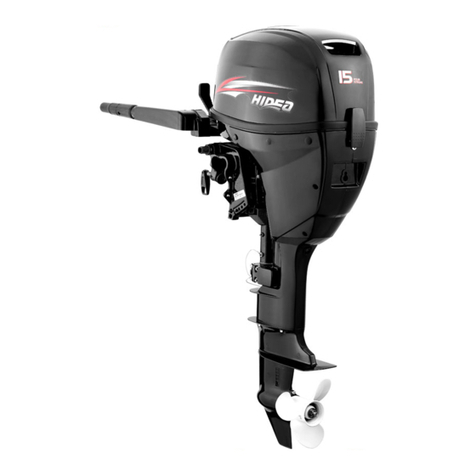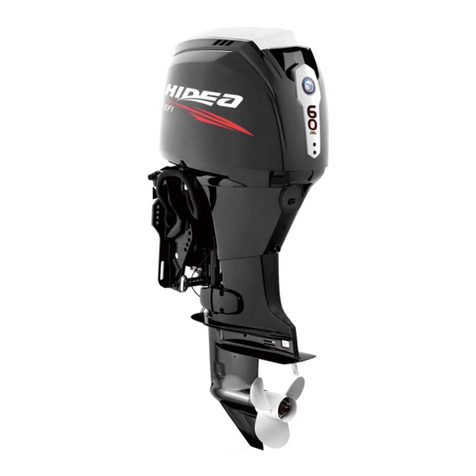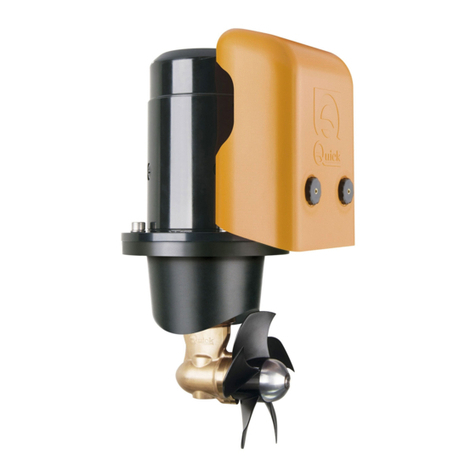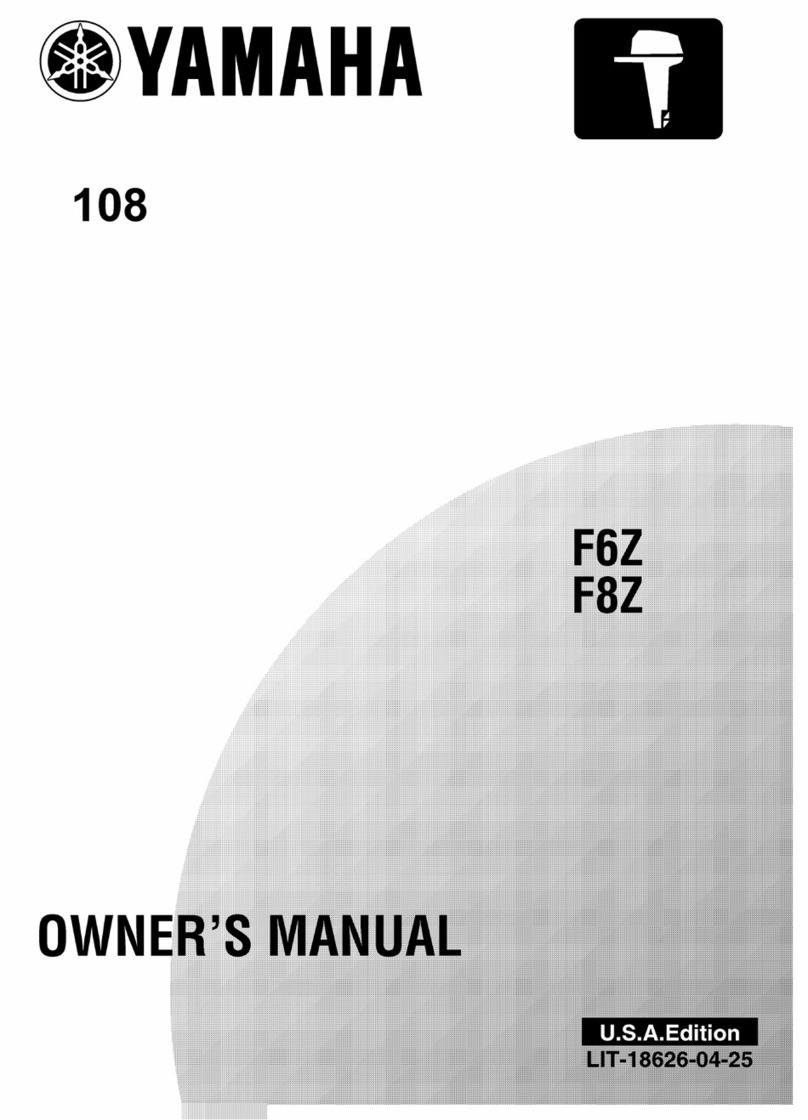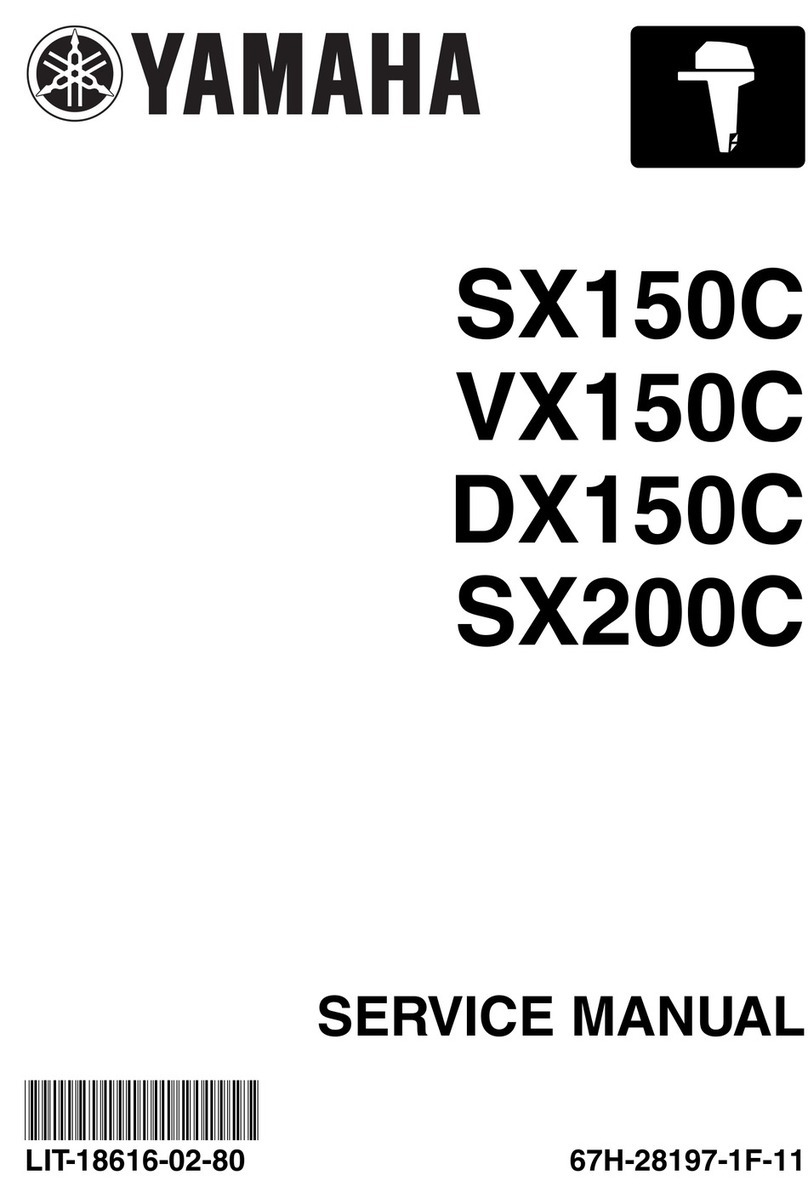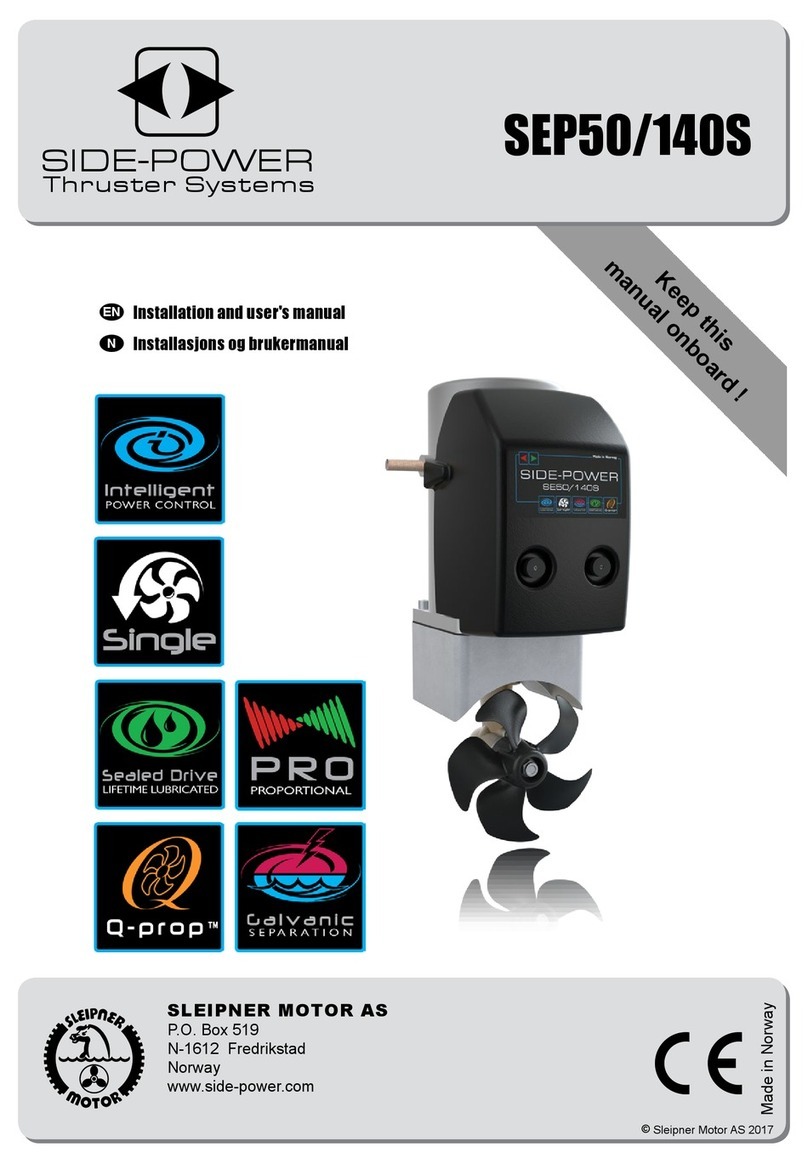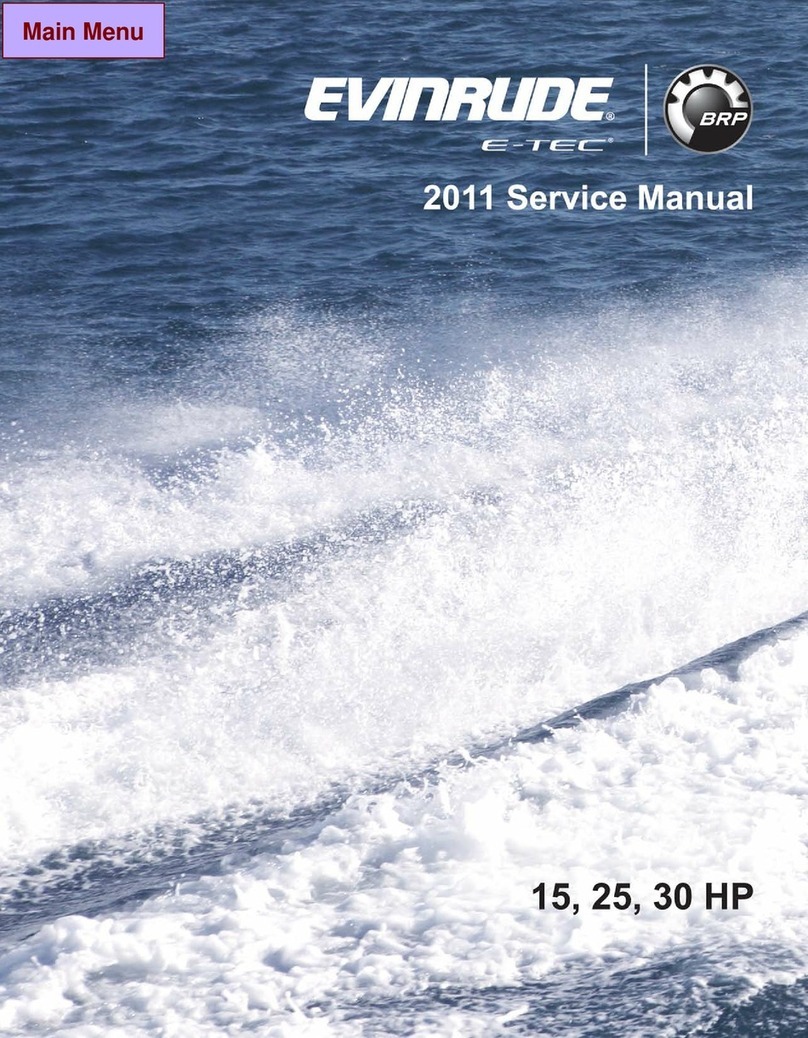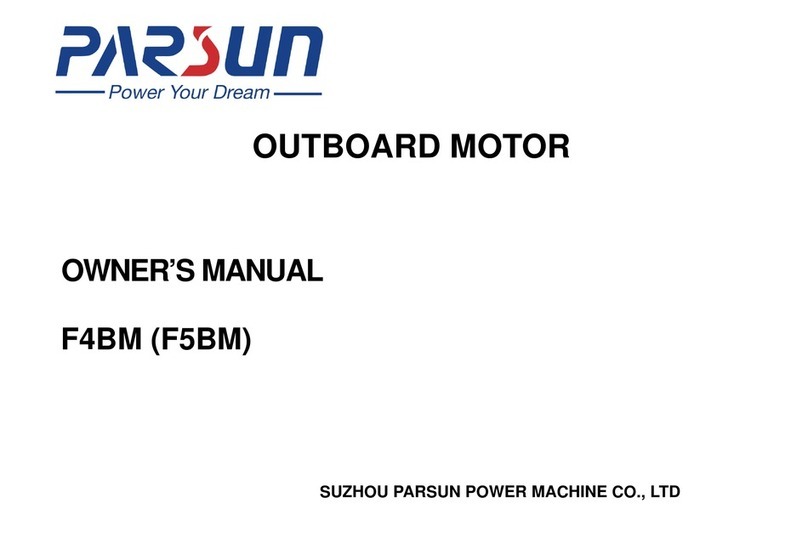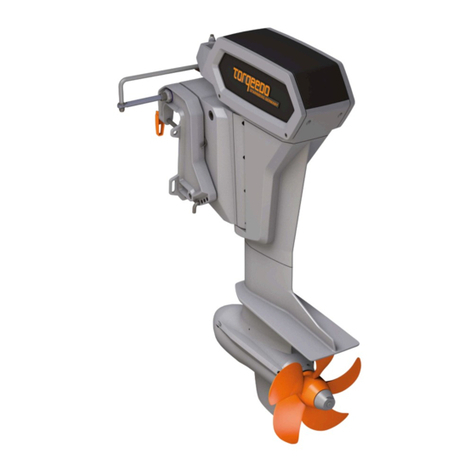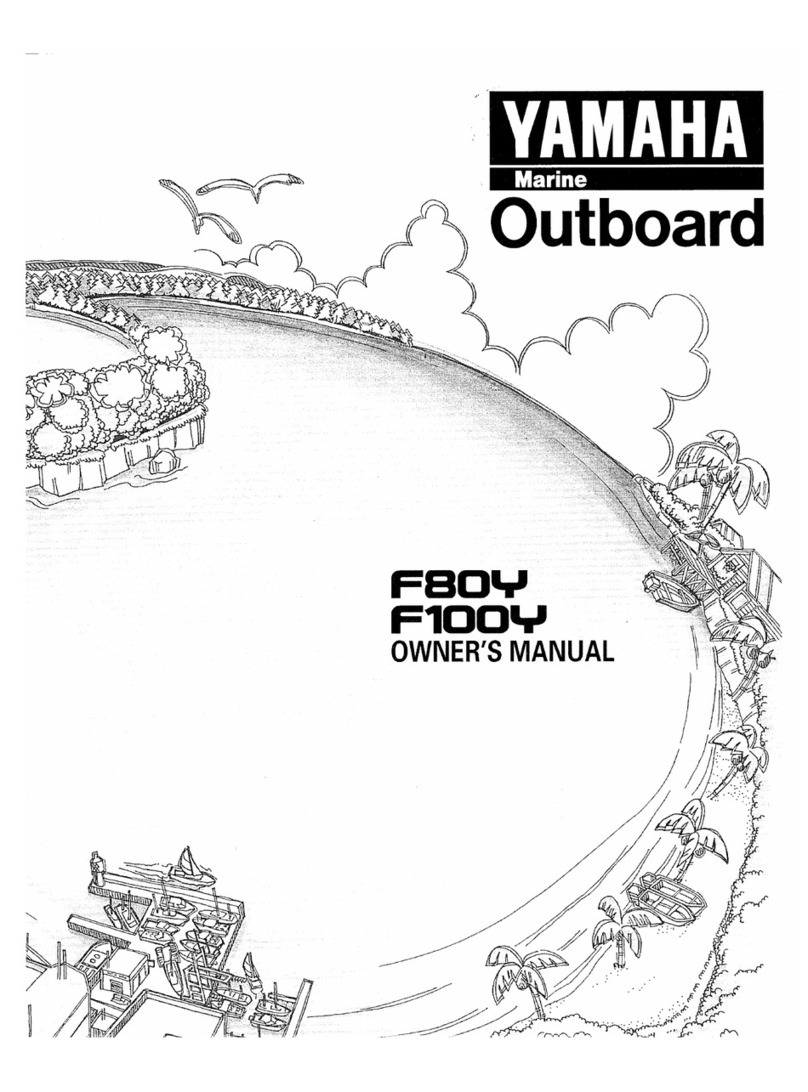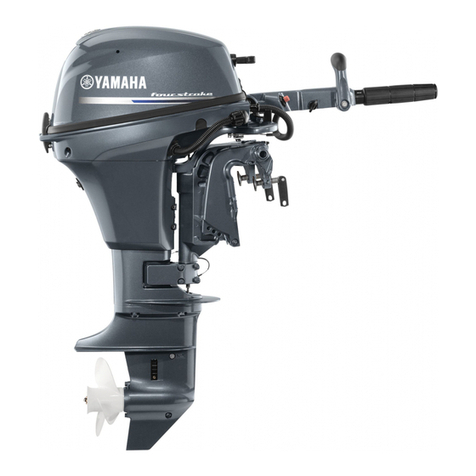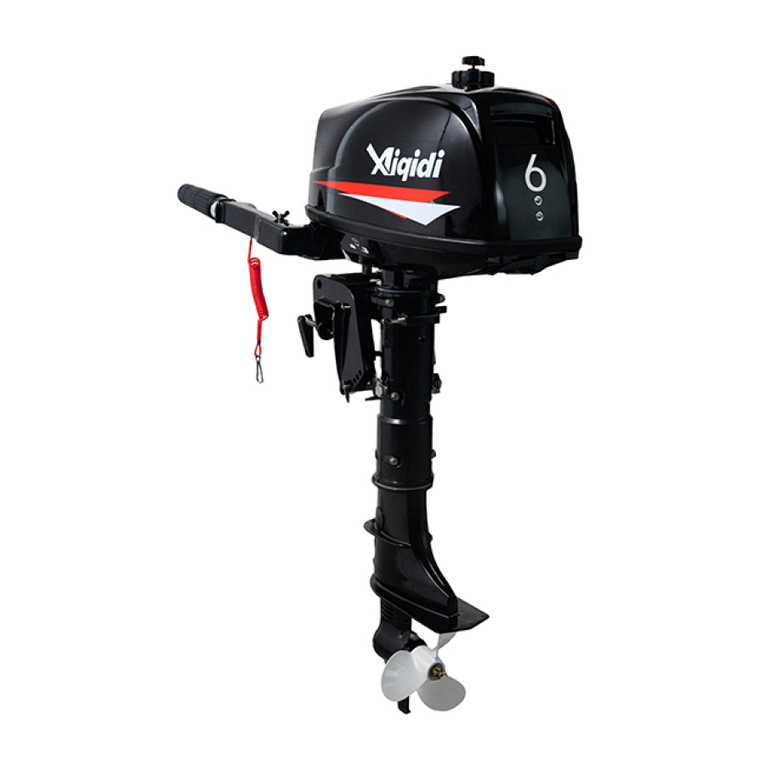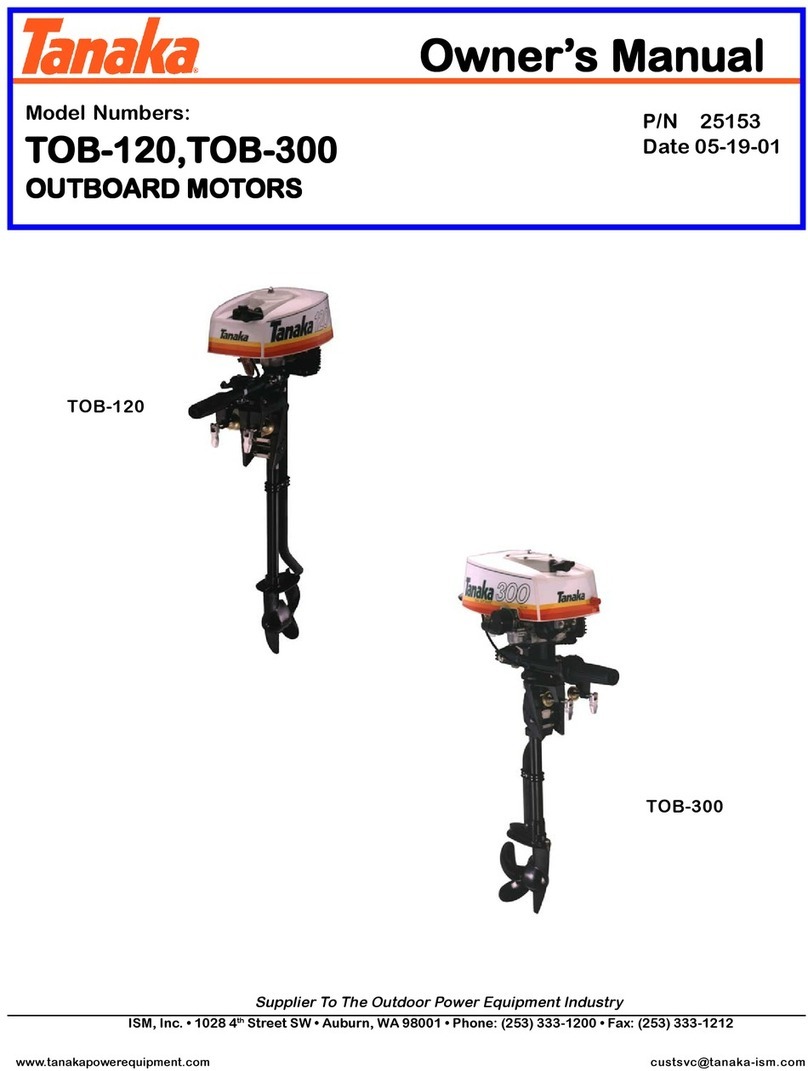Hidea HDF2.5 User manual

HangZhou Hidea Power Machinery Co. , Ltd.
Nautimarket Srl - ITALY
www.hidea.ws
www.nautimarket.com

Thank you for choosing a HIDEA outboard motor. This Owner’s Manual contains information
needed for proper operation, maintenance and care. A thorough understanding of these simple
instructions will help you obtain maximum enjoyment from your HIDEA. If you have any
question about the operation or maintenance of your outboard motor, please consult a HIDEA
corporation.
In this Owner’s Manual particularly important information is distinguished in the following
ways.
The Safety Alert Symbol means ATTENTION! BECOME ALERT! YOUR SAFETY IS
INVOLVED!
WARNING
Failure to follow WARNING instructions could result in severe injury or death to the machine
operator, a bystander, or a person inspection or repairing the outboard motor.
CAUTION
A CAUTION indicates special precautions that must be taken to avoid damage to the outboard
motor.
NOTE
A NOTE provides key information to make procedures easier or clearer.
To ensure long product life, HIDEA recommends that you use the product and perform the
specied periodic inspections and maintenance by correctly following the instructions in the
owner’s manual. Note that if you do not follow these instructions, not only may the product break
down, but the warranty will also be voided.
NOTE
The F2.5AMH and the standard accessories are used as a base for the explanations and
illustrations in this manual. Therefore some items may not apply to every model.
Important manual information
To the owner

General information
Read manuals and labels
Warning labels
Fueling instructions
Gasoline
Engine oil
Propeller selection
Basic components
Main components
Fuel tank cap
Air vent screw
Gear shift lever
Throttle grip
Throttle friction adjuster
Engine stop lanyard switch
Engine stop button
Choke knob for pull type
Manual starter handle
Steering friction adjuster
Trim rod
Tilt support lever
Operation
Installation
Mounting the outboard motor
Clamping the outboard motor
Breaking in engine
Procedure for 4-stroke models
Pre-operation checks
Fuel
Controls
Engine
Checking the engine oil level
Filling fuel for built-in tank
Operation engine
Feeding fuel
Starting engine
Warming up engine
Manual start models
Shifting
Forward or reverse
Table of contents
1
2
2
3
3
4
4
6
6
7
7
8
8
9
9
9
10
10
10
11
11
12
12
12
13
14
14
14
14
14
14
14
15
15
15
16
18
18
18
18

Stopping engine
Procedure
Trimming outboard motor
Adjusting trim angle
Adjusting boat trim
Tilting up and down
Procedure for tilting up
Procedure for tilting down
Maintenance
Specications
Transporting and storing outboard motor
Clamp screw mounting models
Storing outboard motor
Procedure
Lubrication
Cleaning the outboard motor
Checking painted surface of motor
Periodic maintenance
Replacement parts
Maintenance chart
Greasing
Cleaning and adjusting spark plug
Checking fuel system
Inspection idling speed
Changing engine oil
Checking wiring and connectors
Exhaust leakage
Water leakage
Engine oil leakage
Checking propeller
Removing the propeller
Installing the Propeller
Changing gear oil
Inspecting and replacing anode(s)
Coating the boat bottom
Trouble Recovery
Trouble shooting
Temporary action in emergency
Impact damage
Starter will not operate
Emergency Starting Engine
Treatment of submerged
Procedure
Table of contents
19
19
19
19
19
21
22
23
24
24
26
26
27
27
28
29
29
29
29
30
31
31
32
33
33
35
35
35
35
35
36
36
37
38
38
40
40
43
43
44
44
46
47

General information
Identication numbers record (HDF2.5)
Outboard motor serial number (SN: )
The outboard motor serial number is stamped on the label attached to the port side of the clamp bracket.
Record you outboard motor serial number in the spaces provided to assist you in ordering spare
parts from your HIDEA dealer or for reference in case your outboard motor is stolen.
1 Outboard motor serial number location Safety information
• Before mounting or operating the outboard motor, read this entire manual. Read it should give
you an understanding of the motor and its operation.
• Before operating the boat, read any owner’s or operator’s manuals supplied with it and all labels.
Be sure you understand each item before operating.
• Do not overpower the boat with this outboard motor. Overpowering the boat could result in loss
of control. The rated power of the outboard should be equal to or less than the rated horsepower
capacity of the boat. If the rated horsepower capacity of the boat is unknown, consult the dealer
or boat manufacturer.
• Do not modify the outboard. Modications could make the motor unt or unsafe to use.
Incorrect propeller selection and incorrect use may not only cause engine damage, but also
adversely affect fuel consumption. Consult your dealer for correct use.
• Never operate after drinking alcohol or taking drugs. About 50% of all boating fatalities involve
intoxication.
• Have an approved personal otation device (PFD) on board for every occupant. It is a good idea
to wear a PFD whenever boating. At a minimum, children and non-swimmers should always wear
PFDs, and everyone should wear PFDs when there are potentially hazardous boating conditions.
• Gasoline is highly ammable, and its vapors are ammable and explosive. Handle and store
gasoline carefully. Make sure there are no gas fumes or leaking fuel before starting the engine.
• This product emits exhaust gases which contain carbon monoxide, a colorless, odorless gas
which may cause brain damage or death when inhaled. Symptoms include nausea, dizziness, and
drowsiness. Keep cockpit and cabin areas well ventilated. Avoid blocking exhaust outlets.
• Check throttle, shift, and steering for proper operation before starting the engine.
• Attach the engine stop switch lanyard cord to a secure place on your clothing, or your arm or leg
while operation. If you accidentally leave the helm, the cord will pull from the switch, stopping
the engine.
• Know the marine laws and regulations where you will be boating ------and obey them.
• Stay informed about the weather. Check weather forecasts before boating. Avoid boating in hazardous
weather.
1

General information
• Tell someone where you are going: leave a Float Plan with a responsible person. Be sure to cancel the
Float Plan when you return.
• Use common sense and good judgment when boating. Know your abilities, and be sure you
understand how your boat handles under the different boating conditions you may encounter.
Operate within your limits, and the limits of your boat. Always operate at safe speeds, and keep a
careful watch for obstacles and other trafc.
• Always watch carefully for swimmers during the engine operation.
• Stay away from swimming areas.
• When a swimmer is in the water near you shift into neutral and shut off the engine.
• Do not illegally discard empty containers used to replace or replenish oil. For the correct
processing of empty containers, consult the dealer where you purchased the oil.
• When replacing oils used to lubricate the product (engine or gear oil), be sure to wipe away any
spilt oil. Never pour oil without using a funnel or similar device. If necessary, verify the
necessary replacement procedure with the dealer.
• Never illegally discard (dump) the product. Recommends consulting the dealer on discarding
the product.
Read manuals and labels
Before operation or working on this motor:
Read this manual.
Read any manuals supplied with the boat.
Read all label on the outboard motor and the boat.
If you need any additional information, contact your HIDEA dealer.
WARNING LABELS
If these labels are damaged or missing, contact your HIDEA dealer for replacements.
HDF2.5
Gasoline is highly fammable and explosive.Shut off engine before refueling. Tighten tank
cap and air vent screw when not in use.
2

General information
• Keep hands, hair, and clothing away from rotating parts while the engine is runing.
• Do not touch or remove electrical parts when starting or during operation.
• Read Owner’s Manuals and labels.
• Wear an approved personal otationdevice(PFD).
• Ensure shift control is in neutral before starting engine.
Label
CAUTION
This side up.
Fueling instructions
GASOLINE AND ITS VAPORS ARE HIGHLY FLAMMABLE AND EXPLOSIVE!
• Do not smoke when refueling, and keep away from sparks, ames, or other sources of ignition.
• Stop engine before refueling.
• Refuel in a well-ventilated area. Refuel portable fuel tanks off the boat.
• Take care not to spill gasoline. If gasoline spills, wipe it up immediately with dry rags.
• Do not overll the fuel tank.
• Tighten the ller cap securely after refueling.
• If you should swallow some gasoline, inhale a lot of gasoline vapor, or get gasoline in your eyes,
get immediate medical attention.
• If any gasoline spills onto your skin, immediately wash with soap and water. Change clothing if
gasoline spills on it.
• Touch the fuel nozzle to the ller opening or funnel to help prevent electrostatic sparks.
CAUTION
clean gasoline which has been stored in clean containers and is not contaminated
with water or foreign matter.
Gasoline
If knocking or pinging occurs, use a different brand of gasoline or premium unleaded fuel.
Recommended gasoline:
Regular unleaded gasoline
3

General information
Engine oil
If the recommended engine oil grades are not available, select an alternative from the following
chart according to the average temperatures in your area.
All 4-stroke engines are shipped from the factory without engine oil.
Propeller selection
The performance of your outboard motor will be critically affected by your choice of propeller, as
an incorrect choice could adversely affect performance and could also seriously damage the
motor. Engine speed depends on the propeller size and boat load. If engine speed is too high or
too low for good engine performance, this will have an adverse effect on the engine.
For a greater operating load, a smaller-pitch propeller is more suitable as it enables the correct
engine speed to be maintained. Conversely, a larger-pitch propeller is more suitable for a smaller
operation load.
Recommended engine oil:
4-stroke motor oil with a combination of the following SAE and API oil classications
Engine oil type SAE:
10W-30 or 25W-40
Engine oil grade API:
SE, SF, SG, SH,SJ,SL
Engine oil quantity(excluding oil lter):
0.35L(0.37 US qt) (0.31 lmp.qt )
4

General information
NOTE
If the recommended engine oil grades are not available, select an alternative temperatures in your
area.
1. Propeller diameter in inches
2. Propeller pitch in inches
3. Type of propeller ( propeller mark )
NOTE
Select a propeller which will allow the engine to reach the middle or upper half of the operation
rage at full throttle with the maximum boat load. If operation conditions such as light boat loads
then allow the engine r/min to rise above the maximum recommended range, reduce the throttle
setting to maintain the engine in the proper operation range.
5

Basic components
Main components
• May not be exactly as shown; also may not be included as standard equipment on all models.
1Top cowling
2 Lock lever,top cowling
3 Bale handle
4 Tiller friction adjust screw
5 Anti-cavitation plate
6 Propeller
7Cooling water inlet
8 Trim rod
9 Clamp bracket
10 Tiller handle
11 Air-exhaust screw
12 Cover fuel tank
13 Manual starter handle
14 Engine stop button
15 Clamp screw
16 Rope attachment
17 Gear shift lever
18 Choke knob
6

Basic components
Fuel tank
If your model included a fuel tank, its parts and functions are as follows.
1 Fuel tank cap
2 Air vent screw
Fuel tank cap
This cap seals the fuel tank. When removed, the tank can be lled with fuel. To remove the cap,
turn it counterclockwise.
Air vent screw
This screw is on the fuel tank cap. To loosen the screw, turn it counterclockwise.
Fuel cock
The fuel cock turns on and off the supply of fuel from the integral fuel tank to the engine.
1 Fuel cock
Close
To stop fuel ow to the engine, turn the lever to close position.
Always turn the lever close position when the engine is not running.
1
1
2
7

Basic components
Close position
Open
With the lever in this position, fuel ows to the carburetor.
Open position
Tiller handle
To change direction, move the tiller handle to the left or right as necessary.
Gear shift lever
Your outboard has three gear shift positions to provide operation: Forward (F), Neutral (N), and
Reverse (R).
Reduce throttle speed to idle speed.
Always shift outboard into gear with a quick motion.
F: Forward
N: Neutral
F
N
8

Basic components
Throttle grip
The throttle grip is on the tiller handle. Turn the grip counterclockwise to increase speed and
clockwise to decrease speed.
Throttle friction adjuster
A friction device provides adjustable resistance to movement of the throttle grip or the remote
control lever, and can be set according to operator preference.
To increase resistance, turn the adjuster clockwise. To decrease resistance, turn the adjuster
counterclockwise.
1. Throttle friction adjuster
2. Engine stop lanyard switch
WARNING
Do not over tighten the friction adjuster. If there is too much resistance, it could be difcult to
move throttle lever or grip, which could result in an accident.
When constant speed is desired, tighten the adjuster to maintain the desired throttle setting.
Engine stop lanyard switch
The stop switch lock must be attached to the engine stop switch for the engine to run. The hook
should be attached to a secure place on the operators clothing, or arm or leg. Should the operator
fall overboard or leave the helm, the hook will pull out the stop switch lock, stopping ignition to
the engine. This will prevent the boat from running away under power.
2
1
9

Basic components
WARNING
Attach the engine stop switch lanyard to a secure place on your clothing, or your arm or leg while
operating.
Do not attach the lanyard to clothing that could tear loose. Do not route the lanyard where is could
become entangled, preventing it from functioning.
Avoid accidentally pulling the lanyard during normal operation. Loss of engine power means the
loss of most steering control. Also, without engine power, the boat could slow rapidly. This could
cause people and objects in the boat to be thrown forward.
NOTE:
The engine cannot be started with the stop switch lock removed.
Engine stop button
To open the ignition circuit and stop the engine, push this button.
Choke knob for pull type
To supply the engine with the rich fuel mixture required start, pull out this knob.
Manual starter handle
To start the engine, rst gently pull the handle out until resistance is felt. From that position, then
pull the handle straight out quickly to crank the engine.
10

Basic components
Steering friction adjuster
A friction device provides adjustable resistance to the steering mechanism, and can be set
according to operator preference. An adjusting screw or bolt is located on the swivel bracket.
To increase resistance, turn the adjuster clockwise.
To decrease resistance, turn the adjuster counterclockwise.
WARNING
Do not over tighten the friction adjuster. If there is too much resistance, it could be difcult to
steer, which could result in an accident.
Thrust rod
The position of the thrust rod determines the minimum trim angle of the outboard motor in
relation to the transom.
Tilt support lever
To keep the outboard motor in the tilted up position, lock the tilt support lever to the clamp
bracket.
Top cowling lock lever
To remove the engine top cowling, pull up the lock lever and lift off the cowling. When installing
the cowling, check to be sure it ts properly in the rubber seal. Then lock the cowling by moving
the lever(s) downward.
11

Basic components
A carrying handle is provided on the rear of the outboard motor. It enables you to carry the
outboard motor easily with one hand.
12

Operations
Installation
CAUTION
Incorrect engine height or obstructions to smooth water ow (such as the design or condition of
the boat, or accessories such as transom ladders or depth nder transducers) can create airborne
water spray while the boat is cruising. Severe engine damage may result if the motor is operated
continuously in the presence of airborne water spray.
NOTE:
During water testing check the buoyancy of the boat, at rest, with its maximum load. Check that
the static water level on the exhaust housing is low enough to prevent water entry into the
powerhead, when water rises due to waves when the outboard is not running
Mounting the outboard motor
WARNING
• Overpowering a boat could cause se vere instability. Do not install an outboard motor with more
horsepower than the maximum rating on the capacity plate of the boat. If the boat does not have a
capacity plate, consult the boat manufacturer.
• The information presented in this section is intended as reference only. It is not possible to
provide complete instructions for every possible boat and motor combination. Proper mounting
depends in part on experience and the specic boat and motor combination.
Improper mounting of the outboard motor could result in hazardous conditions such as poor
handling, loss of control, or re hazards. Observe the following:
• For permanently mounted models, your dealer or other person experienced in proper rigging
should mount the motor. If you are mounting the motor yourself, you should be trained by an
experienced person.
• For portable models, your dealer or other person experienced in proper outboard motor mounting
should show you how to mount your motor.
Mount the outboard motor on the center line(keel line) of the boat, and ensure that the boat itself
is well balanced. Otherwise the boat will be hard to steer. For boats without a keel or which are
asymmetrical, consult your dealer.
1.Center line(keel line)
1
13

Operations
Mounting height
To run your boat at optimum efciency, the water resistance (drag) of the boat and outboard
motor must be made as little as possible. The mounting height of the outboard motor greatly
affects the water resistance. If the mounting height is too high, cavitation tends to occur, thus
reducing the propulsion; and if the propeller tips cut the air, the engine speed will rise abnormally
and cause the engine to overheat. If the mounting height is too low, the water resistance will
increase and thereby reduce engine efciency. Mount the outboard motor so that the anticavitation
plate is between the bottom of the boat and a level 30-50mm (1.2-2 in.) below it.
NOTE:
• The optimum mounting height of the outboard motor is affected by the boat and motor
combination and the desired use. Test runs at different heights can help determine the optimum
mounting height. Consult your boat manufacturer for further information on determining the
proper mounting height.
Clamping the outboard motor
1. Place the outboard motor on the transom so that it is positioned as close to the center as
possible. Tighten the transom clamp screws evenly and securely. Occasionally check the clamp
screws for tightness during operation of the outboard motor because they could become loose
due to engine vibration.
WARNING
Loose clamp screws could allow the outboard motor to fall off or move on the transom. This could
cause loss of control and serious injury. Make sure the transom screws are tightened securely.
Occasionally check the screws for tightness during operation.
14

Operations
2. If the engine restraint cable attachment is equipped on your engine, an engine restraint cable or
chain should be used. Attach one end to the engine restraint cable attachment and the other to a
secure mounting point on the boat. Otherwise the engine could be completely lost if it
accidentally falls off the transom.
Breaking in engine
Your new engine requires a period of break-in to allow mating surfaces of moving parts to wear in
evenly. Correct break-in will help ensure proper performance and longer engine life.
CAUTION
Failure to follow the break-in procedure could result in reduced engine life or even severe engine
damage.
Procedure for 4-stroke models
Run the engine under load (in gear with a propeller installed) as follows.
1. For the rst hour of operation:
Run the engine at 3000 r/min or at approximately half throttle.
2. For the second hour of operation:
Run the engine at 4000 r/min or at approximately three-quarter throttle.
3. For the next eight hours of operation:
Avoid continuous operation at full throttle for more than ve minutes at a time.
4. After the rst 10 hours:
Operate the engine normally.
Pre-operation checks
WARNING
If any item in the preoperation check is not working properly, have it inspected and repaired
before operating the outboard motor. Otherwise an accident could occur.
CAUTION
Do not start the engine out of water. Overheating and serious engine damage can occur.
Fuel
• Check to be sure you have plenty of fuel for your trip.
• Make sure there are no feel leaks or gasoline fumes.
15

Operations
Controls
• Check throttle, shift, and steering for proper operation before starting the engine.
• The controls should work smoothly, without binding or unusual free play.
• Look for loose or damaged connections.
• Check operation of the starter and stop switches when the outboard motor is in the water.
Engine
• Check the engine and engine mounting.
• Look for loose or damaged fasteners.
• Check the propeller for damage.
Checking the engine oil level
1. Put the outboard motor in an upright position (not tilted).
2. Check the oil level using the oil ller cap to be sure the level falls between the upper and lower
marks. Fill with oil if it is below the lower mark, or drain to the specied level if it is abovethe
uppper mark.
1.Oil level check window
1.Lower level mark
2. Upper level mark
Filling fuel for built-in tank
WARNING
Gasoline and its vapors are highly ammable and explosive. Keep away from sparks, cigarettes,
ames, or other sources of ignition.
1. With the outboard motor tilted down (in the vertical running position), remove the fuel tank cap.
2. Use a funnel if the nozzle on the fuel can or pump is not small enough or long enough to t into the
mouth of the fuel tank.
3. Fill the fuel tank carefully.
4. Securely close the cap after refueling. Wipe up any spilled fuel.
1
16
Table of contents
Other Hidea Outboard Motor manuals


